|
|
|
|
|
Oil On
Canvas, Real Flavor of Old Masters
|
|

|
ARTWORKS
INDEX
A B C D E F G H I J K L M N O P Q R S T U V W X Y Z |
ARTISTS
INDEX
A B C D E F G H I J K L M N O P Q R S T U V W X Y Z |
|
|
| | |
|
|
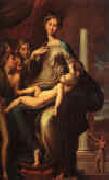 |
Girolamo Parmigianino -- Click Here
|
|
1503-1540 Italian Girolamo Parmigianino Galleries |
|
 |
Girolamo Nerli -- Click Here
|
|
1860-1926,was an Italian painter who worked and travelled in Australia and New Zealand in the late 19th century influencing Charles Conder and Frances Hodgkins and helping to move Australian and New Zealand art in new directions. His portrait of Robert Louis Stevenson in the Scottish National Portrait Gallery Edinburgh, is usually considered the most searching portrayal of the writer. Born in Siena in Italy to an Italian aristocrat, Ferdinando Pieri Nerli, his full name was Girolamo Pieri Pecci Ballati Nerli. The fourth of six children he was not a 'Marchese' as he was sometimes styled, or a 'Count', but a 'patrizio di Siena', a minor distinction marking the great antiquity of his family. His father married Henrietta Medwin, an Englishwoman. Her father Thomas Medwin was a minor literary figure in Byron's circle, the author of Journal of the Conversations of Lord Byron and of The Life of Percy Bysshe Shelley; Medwin was a distant relation of Shelley. Girolamo studied art in Florence under Antonio Ciseri and Giovanni Muzzioli and was a younger member of the Italian Macchiaioli school, the 'patch painters', an Italian movement anticipating French Impressionism. He went to Australia in 1885 spending time in Melbourne and Sydney where he was an associate of Tom Roberts and Arthur Streeton and an influence on Charles Conder at the time of the Heidelberg School. Nerli's role in that movement has been disputed but his presence and influence are undeniable. was an Italian painter who worked and travelled in Australia and New Zealand in the late 19th century influencing Charles Conder and Frances Hodgkins and helping to move Australian and New Zealand art in new directions. His portrait of Robert Louis Stevenson in the Scottish National Portrait Gallery Edinburgh, is usually considered the most searching portrayal of the writer. Born in Siena in Italy to an Italian aristocrat, Ferdinando Pieri Nerli, his full name was Girolamo Pieri Pecci Ballati Nerli. The fourth of six children he was not a 'Marchese' as he was sometimes styled, or a 'Count', but a 'patrizio di Siena', a minor distinction marking the great antiquity of his family. His father married Henrietta Medwin, an Englishwoman. Her father Thomas Medwin was a minor literary figure in Byron's circle, the author of Journal of the Conversations of Lord Byron and of The Life of Percy Bysshe Shelley; Medwin was a distant relation of Shelley. Girolamo studied art in Florence under Antonio Ciseri and Giovanni Muzzioli and was a younger member of the Italian Macchiaioli school, the 'patch painters', an Italian movement anticipating French Impressionism. He went to Australia in 1885 spending time in Melbourne and Sydney where he was an associate of Tom Roberts and Arthur Streeton and an influence on Charles Conder at the time of the Heidelberg School. Nerli's role in that movement has been disputed but his presence and influence are undeniable. |
|
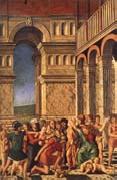 |
Girolamo Mocetto -- Click Here
|
|
Italian Painter, ca.1470-1531,Italian engraver, painter and designer of stained glass. He was born into a family of glass painters, and, although there is no documentary evidence that he worked outside Venice, his early paintings and engravings show the influence of Domenico Morone and of Mantegna and his circle, which would suggest that Mocetto's training may not have been exclusively Venetian. His artistic evolution is most clearly seen in a comparison of early works still close to Morone, such as a series of three engravings of the Battle between Israel and the Amalekites (see Hind, nos 719-20) or the painting of the Battle (Pavia, Pin. Malaspina), to works of a few years later, such as the two small paintings of the Massacre of the Innocents (London, N.G.; see fig.) and the engravings of Pagan Sacrifices (H 726-7), the Metamorphosis of Amymone (H 728) and the Calumny of Apelles (H. 727), all datable to c. 1500. In the later works, whole passages or motifs are copied or adapted from drawings and engravings by Mantegna. Mocetto may have had direct contact with the court of Mantua (the Metamorphosis of Amymone is an allegory of the city of Mantua); two engravings dating from the first years of the 16th century, St John the Baptist (H 724) and Judith with the Head of Holofernes (H 725), |
|
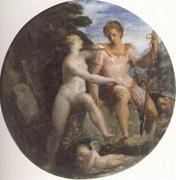 |
Girolamo Macchietti -- Click Here
|
|
Italian Painter , Firenze1535-1592
was an Italian painter active in Florence, working in a Mannerist style. He was a pupil of Michele di Ridolfi. During 1556-62, worked as an assistant to Giorgio Vasari in the decoration of the Palazzo Vecchio, where he worked with Mirabello Cavalori. He participated in the Vasari-directed decoration of the Studiolo of Francesco I with two canvases, one relating a Jason and Medea (1570) and the other a Baths of Pozzuoli (1572). He also painted an altarpiece on the Martyrdom of Saint Lawrence for Santa Maria Novella. In 1577, he completed a Gloria di San Lorenzo for Empoli Cathedral. He traveled to Rome and spent two years in Spain (1587-1589). |
|
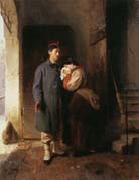 |
Girolamo Induno -- Click Here
|
|
13/12/1825 - 18/12/1890 |
|
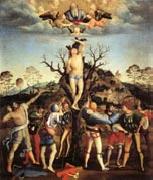 |
Girolamo Genga -- Click Here
|
|
Italian Painter and Architect , 1476-ca.1551
was an Italian painter and architect of the late Renaissance, Mannerist Genga was born near Urbino. According mainly to Giorgio Vasari's biography, by age thirteen Genga had gained an apprenticeship in Orvieto under Luca Signorelli. He was afterwards for three years with Pietro Perugino, in company with Raphael. He next worked in Florence and Siena (where he decorated the Petrucci palace c. 1508), along with Timoteo della Vite; and in the latter city he painted various compositions for Pandolfo Petrucci, a leading local statesman. Returning to Urbino, he was employed by Duke Guidobaldo da Montefeltro in the decorations of his palace, and showed extraordinary aptitude for theatrical adornments. He is recorded as having help design the decorations for the Duke's funeral in 1508. From Urbino, he went to Rome and painted church of Santa Caterina da Siena one of his masterpieces: The Resurrection. Francesco Maria I della Rovere, duke of Urbino, recalled Genga, and commissioned him to execute works in connection with his marriage to Eleonora Gonzaga in 1522. This prince being soon afterwards expelled by Pope Leo X, Genga followed him to Mantua, whence he went for a time to Pesaro. The duke of Urbino was eventually restored to his dominions; he took Genga with him, and appointed him the ducal architect and decorator. He worked extensively on the Villa Imperiale on Mount Accio . Among his work in Urbino, was the scenography of plays, |
|
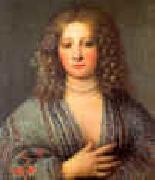 |
Girolamo Forabosco -- Click Here
|
|
1604-1679
Italian
Girolamo Forabosco Location
Italian painter. He was active in Padua and Venice, where he was enrolled in the Fraglia dei Pittori between 1634 and 1639 and paid taxes from 1640 to 1644. His early work, such as the portrait of the so-called Menichina (1624; Rome, Pal. Barberini), was influenced by that of Alessandro Varotari (Padovanino), who had revived the style of Titian. He also adopted compositional and formal schemes from Tiberio Tinelli, as in the Portrait of a Woman. The large canvas of the Miraculous Rescue (1646; Malamocco, S Maria Assunta), commissioned by Giovanni Ventura as an ex-voto for his escape from a shipwreck, shows Forabosco, unconstrained by the narrative and devotional character premises of the undertaking, creating a tender portrait group, distinguished by its spontaneity. The most striking quality of his work is its combination of physiognomic exactitude with free, fluid brushwork. |
|
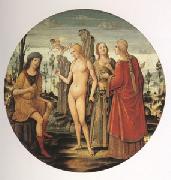 |
Girolamo di Benvenuto -- Click Here
|
|
Siena 1470-ca 1524 |
|
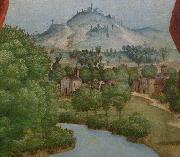 |
Girolamo dai Libri -- Click Here
|
|
(1474/1475 - July 2, 1555) was an Italian illuminator of manuscripts and painter of altarpieces, working in an early-Renaissance style.
He was born and mainly active in Verona. His father was Francesco dai Libri, and was so named because he was an illuminator of books. Girolamo's works were noted by Giorgio Vasari. Girolamo was a pupil of Domenico Morone. Dai Libri painted his first altarpiece, a Deposition from the Cross for Santa Maria in Organo in Verona, at the age of sixteen.
|
|
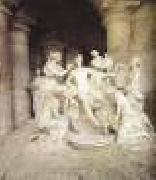 |
GIRARDON, Francois -- Click Here
|
|
French Baroque Era Sculptor, 1628-1715
François Girardon was born at Troyes on March 17, 1628. He studied in Rome for an undetermined period of time between 1645 and 1650. He then studied at the Royal Academy in Paris and was admitted to the academy as a member in 1657. Much of Girardon's most important work was executed for King Louis XIV and consisted of major commissions for the palace and gardens of Versailles. One of Girardon's most famous productions is Apollo and the Nymphs of Thetis in Versailles (1666-1672), originally designed for a grotto there. This elaborate project of seven separate marble statues depicts the god Apollo surrounded by nymphs, and it exemplifies with exceptional clarity the French interpretation of the baroque style in sculpture, an interpretation that rejected the fluid, dramatic, and emotional Italian baroque in favor of a cooler, more sober approach based upon the sculpture of antiquity. The Apollo group is filled with references to Hellenistic and Roman sculpture, and while Girardon was working on the commission he made a second trip to Rome for inspiration from antique sources. The ancient world, however, had never attempted to assemble several large pieces of free-standing sculpture into one unified composition, and in solving this problem Girardon had recourse to the paintings of Nicolas Poussin, the great French baroque classicist. The classicism of the Apollo group conformed fully to the official style of the French Academy and the personal taste of Louis XIV, but the composition has many baroque elements. The vigor and variety in the movement of the figures, the rich textural contrasts, the grand scale of the project, and the dramatic use of space are all stylistic qualities that firmly link the work to the international baroque style. One of Girardon's most important works is the tomb of Cardinal Richelieu in the church of the Sorbonne, Paris (1675-1677). This monument shows the dying prelate in a semireclining position, his vestments falling in broad curves that are echoed in the draperies of the allegorical figures at the head and foot of the tomb. As originally placed in the church, the monument was freestanding so that the spectator was compelled to enter into the action of the work - a typical baroque compositional device. Girardon's most significant late work was a majestic bronze equestrian statue of Louis XIV (1683-1692) executed for the Place Vendôme in Paris and based upon the famous Roman equestrian monument of the emperor Marcus Aurelius. |
|
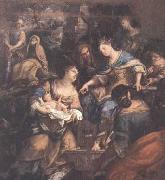 |
Giovanni Tuccari -- Click Here
|
|
Giovanni Tuccari (1667-1743) was an Italian painter during the Baroque period, active in Sicily.
Tuccari was born in Messina. He was the son and pupil of Antonio Tuccari, an obscure painter. He excelled as a battle painter. He died of the plague. He was responsible for the frescos in the Church of San Benedetto in Catania. Other examples of his work include four octagonal paintings in the sanctuary of the Church of S. Antonio, at Castiglione di Sicilia, and La Pinacoteca Zelantea gallery in Acireale.
|
|
 |
Giovanni Toscani -- Click Here
|
|
Italian Painter, ca.1370-1430 |
|
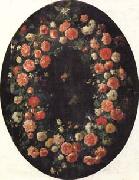 |
Giovanni Stanchi -- Click Here
|
|
Italian, 1608-died after 1673 |
|
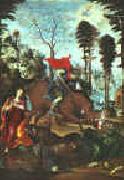 |
Giovanni Sodoma -- Click Here
|
|
1477-1549
Giovanni Sodoma Galleries |
|
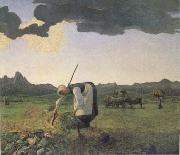 |
Giovanni Segantini -- Click Here
|
|
Italian Art Nouveau Painter, 1858-1899
Italian painter and draughtsman. An exponent of DIVISIONISM, he was the only Italian painter of the late 19th century to have enjoyed an unbroken international reputation, especially in Germany and Austria. |
|
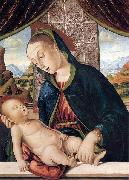 |
Giovanni Santi -- Click Here
|
|
(c. 1435 - 1 August 1494) was an Italian painter and decorator, father of Raphael. He was born at Colbordolo in the Duchy of Urbino. He was a petty merchant for a time; he then studied under Piero della Francesca. He was influenced by Fiorenzo di Lorenzo, and seems to have been an assistant and friend of Melozzo da Forle. He was court painter to the Duke of Urbino and painted several altarpieces, two now in the Berlin Museum, a Madonna in the church of San Francesco in Urbino, one at Santa Croce on Fano, one in the National Gallery at London, and another in the gallery at Urbino; an Annunciation at the Brera in Milan; a resurrected Christ in the Museum of Fine Arts, Budapest; and a Jerome in the Lateran. He died in Urbino.
|
|
|
|
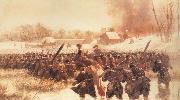 |
Giovanni Ponticelli -- Click Here
|
|
Italian, 1855-1877 |
|
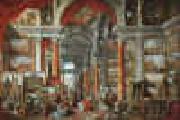 |
Giovanni Paolo Pannini -- Click Here
|
|
1691-1765
Italian
Giovanni Paolo Pannini Galleries
Italian painter. After gaining fame for his fresco painting, he specialized in Roman topography and became the foremost artist in that field in the 18th century. His real and imaginary views of ancient Roman ruins embody precise observation and tender nostalgia and combine elements of late classical Baroque art with incipient Romanticism. His work was popular both with tourists and his peers: he was admitted to the Acad??mie Française in 1732 and became its professor of perspective. |
|
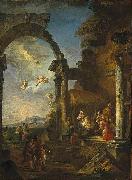 |
Giovanni Paolo Panini -- Click Here
|
|
17 June 1691 - 21 October 1765) was an Italian painter and architect, mainly known as one of the vedutisti .
As a young man, Panini trained in his native town of Piacenza, under Giuseppe Natali and Andrea Galluzzi, and later the stage designer Francesco Galli-Bibiena. In 1711, he moved to Rome, where he studied drawing with Benedetto Luti and became famous as a decorator of palaces, including the Villa Patrizi (1719-1725), the Palazzo de Carolis (1720), and the Seminario Romano (1721-1722). In 1719, Panini was admitted to the Congregazione dei Virtuosi al Pantheon. He taught in Rome at the Accademia di San Luca and the Academie de France, where he influenced Jean-Honore Fragonard. In 1754, he served as the principal of the Accademia di San Luca. Panini died in Rome on 21 October 1765
As a painter, Panini is best known for his vistas of Rome, in which he took a particular interest in the city's antiquities. Among his most famous works are the interior of the Pantheon, and his vedute paintings of picture galleries containing views of Rome. Most of his works, specially those of ruins have a substantial fanciful and unreal embellishment characteristic of capriccio themes. |
|
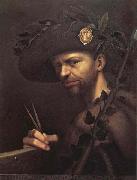 |
Giovanni Paolo Lomazzo -- Click Here
|
|
1538 - 1600
was an Italian painter, belonging to the second generation that produced Mannerism in Italian art and architecture. Gian Paolo Lomazzo was born in Milan from a family emigrated from the town of Lomazzo. His early training was with Giovan Battista della Cerva in Milan. He painted a large Allegory of the Lenten Feast for San Agostino in Piacenza (1567). He also painted an elaborate dome with Glory of Angels for the Capella Foppa in San Marco in Milan. He also painted the Fall of Simon Magus in the wall of the chapel. Lomazzo became blind in 1571, and turning to writing, produced two complex treatises that are milestones in the development of art criticism. His first work, Trattato dell'arte della pittura, scoltura et architettura (1584) is in part a guide to contemporary concepts of decorum, which the Renaissance inherited in part from Antiquity, which controlled a consonance between the functions of interiors and the kinds of painted and sculpted decors that would be suitable; Lespingola offered a systematic codification of esthetics that typifies the increasingly formalized and academic approaches typical of the later sixteenth century. His less practical and more metaphysical Idea del tempio della pittura ("The ideal temple of painting", 1590) offers a description along the lines of the "four temperaments" theory of the human nature and personality, |
|
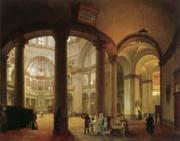 |
Giovanni Migliara -- Click Here
|
|
Italian 1785-1837
He began his career as a scene painter with Gaspare Galiari (1761-1823) in Milan, working at the Teatro Carcano in 1804 and at La Scala from 1805 to 1809. Owing to illness, after 1810 he turned to small-scale works in watercolour or oil using various supports, including silk and ivory. At this date Milanese painting was dominated by Andrea Appiani and Luigi Sabatelli, both leading Neo-classical artists. However, Migliara remained aloof from this dominant movement and instead drew on medieval and historical subjects with Romantic undertones. His precise, jewel-like technique and choice of subject-matter found favour with aristocratic patrons in Milan. His figures are generally stilted and burdened by their costumes, though the crowd in Sacking of Minister Prina's House (1814; Milan, Gal. A. Mod.) is depicted with unusual fluency. In 1822 Migliara was appointed Professor of Perspective at the Accademia di Belle Arti, Milan, and in 1833 he was nominated painter to the court of Charles-Albert, King of Sardinia (reg 1831-49). More typical of his historical scenes is Entrance to the Castle of Plessis de la Tour (Turin, Gal. Civ. A. Mod.), which was exhibited at the Brera in 1833. He also produced many topographically precise pictures of church interiors in which he combined his training as a scene painter with his knowledge of intaglio techniques. |
|
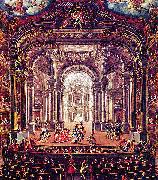 |
Giovanni Michele Graneri -- Click Here
|
|
painted The Teatro Regio in Turin in 1752 |
|
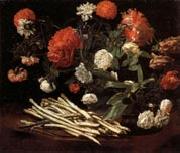 |
Giovanni Martinelli -- Click Here
|
|
Italian Baroque Era Painter, 1610-1659 |
|
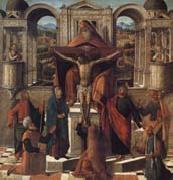 |
Giovanni Mansueti -- Click Here
|
|
Italian Early Renaissance Painter, active 1484-ca.1526, was an Italian painter. Also known as Giovanni Mansueti. Known by a few paintings. Little is known of his biography. He was active in Venice from 1485 to 1526. Pupil of Gentile Bellini and worked in the antique style in the Miracles of the Cross painted in 1494- c. 1502 for the Scuola di san Giovanni Evangelista and now in the Gallerie dell'Accademia. In style he resembles Cima da Conegliano and Vittore Carpaccio. One of his paintings resides in a church near Bagni di Luca, Italy. |
|
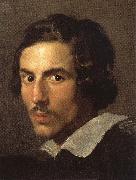 |
Giovanni Lorenzo Bernini -- Click Here
|
|
Italian Baroque sculptor, painter and architect.1598-1680
was a pre-eminent Baroque sculptor and architect of 17th Century Rome. Bernini was born in Naples to a Mannerist sculptor, Pietro Bernini, originally from Florence. At the age of seven he accompanied his father to Rome, where his father was involved in several high profile projects. There as a boy, his skill was soon noticed by the painter Annibale Carracci and by Pope Paul V, and Bernini gained the patronage exclusively under Cardinal Scipione Borghese, the pope's nephew. |
|
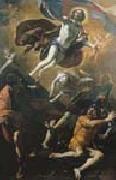 |
Giovanni Lanfranco -- Click Here
|
|
(26 January 1582 - 30 November 1647) was an Italian painter of the Baroque period.
Giovanni Gaspare Lanfranco was born in Parma, the third son of Stefano and Cornelia Lanfranchi, and was placed as a page in the household of Count Orazio Scotti His talent for drawing allowed him to begin an apprenticeship with the Bolognese artist Agostino Carracci, brother of Annibale Carracci, working alongside fellow Parmese Sisto Badalocchio in the local Farnese palaces. When Agostino died in 1602, both young artists moved to Annibale's large and prominent Roman workshop, which was then involved in working on the Galleria Farnese in the Palazzo Farnese gallery ceiling. |
|
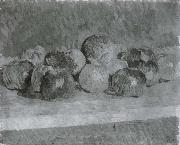 |
Giovanni Giacometti -- Click Here
|
|
Swiss Painter, 1868-1933,was a Swiss painter. He was the father of the artists Alberto and Diego Giacometti and the architect Bruno Giacometti. |
|
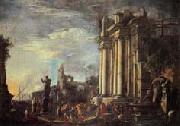 |
Giovanni Ghisolfi -- Click Here
|
|
Italian Painter ,
ca.1623-1683
He first trained with his uncle, Antonio Volpino. In 1650, together with his friend Antonio Busca, he travelled to Rome, where he studied the great compositions of Pietro da Cortona and for some time frequented the studio of Salvator Rosa. In 1661 he returned to Lombardy and worked at the Certosa di Pavia, decorating a whole chapel with frescoes showing Legends of St Benedict (in situ), and later providing a canvas of St Bruno, which is now in the Certosa library. In the background of this picture Ghisolfi painted a sloping landscape in a style very close to that of Pietro da Cortona. In the following years he evidently established a reputation for landscape paintings with architecture and ancient ruins. In 1664 he was called to Vicenza to execute, in the Palazzo Trissino Baston and the Palazzo Giustiniani Baggio, an extensive series of decorative landscape frescoes (partially destr.; known through photographs). Numerous preparatory drawings for these exist (Haarlem, Teylers Mus.; Windsor Castle, Berks, Royal Col.). In the same period Ghisolfi collaborated with Antonio Busca on a series of decorative frescoes in the gallery of Palazzo Borromeo Arese at Cesano Maderno, near Milan, and later, with Federico Bianchi, in the Villa Litta Modigliani (1680) at Varese. Both these works have been gravely damaged by decay and later repaintings. |
|
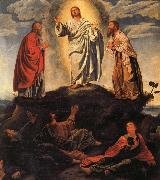 |
Giovanni Gerolamo Savoldo -- Click Here
|
|
Italian Mannerist Painter , c. 1480 - aft.1548
was an Italian High Renaissance painter. Savoldo was born in Brescia, but little is known about his early years. Some sources claim he was known as Girolamo Bresciano. By 1506 he was in Parma, and by 1508, he had joined the Florentine painter??s guild. In this period he finished the Rest at the Flight from Egypt (Augsburg), the Elijah Harassed by a Crow (National Gallery of Art, Washington), and a Deposition. In 1515 he painted the Portrait of a Clad Warrior, wrongly identified with Gaston de Foix. Also from the same period his the Temptings of St. Anthony, which appears to show the influence of the Flemish Hieronymus Bosch. The works was appreciated by the commissioners from Venice, where Savoldo relocated before 1520. On June 15, 1524 he signed a contract for an altarpiece for the church of San Domenico in Pesaro (now in the Brera, Milan). In 1527, he completed a St. Hieronymus for the Brescian family Averoldi, probably the one at National Gallery of London. From the 1530s dates a Nativity at the National Gallery in Washington DC, which seems influenced by the lambent contemporary, Correggio painting on the same topic. In 1533 Savoldo painted a Madonna with Four Saints in the church of Santa Maria in Organo, while in 1537-1538 he executed the altarpiece for the main altar of Santa Croce, Brescia. |
|
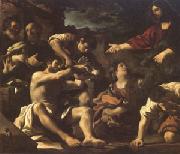 |
Giovanni Francesco Barbieri Called Il Guercino -- Click Here
|
|
Cento 1591-Bologna 1666 |
|
 |
Giovanni Fattori -- Click Here
|
|
Italian Realist Painter , 1825-1908
was an Italian artist, one of the leaders of the group known as the Macchiaioli. He was initially a painter of historical themes and military subjects. In his middle years, inspired by the Barbizon school, he became one of the leading Italian plein-airists, painting landscapes, rural scenes, and scenes of military life. After 1884, he devoted much energy to etching. |
|
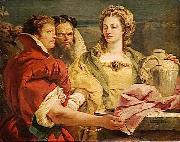 |
Giovanni Domenico Tiepolo -- Click Here
|
|
(August 30, 1727 - March 3, 1804) was a Venetian painter and printmaker in etching. He was the son of artist Giovanni Battista Tiepolo and elder brother of Lorenzo Baldissera Tiepolo..
Domenico was born in Venice, studied under his father, and by the age of 13 was the chief assistant to him. He was one of the many assistants, including Lorenzo, that transferred the designs of his father (executed in the 'oil sketch' invented by the same). By the age of 20, he was producing his own work for commissioners.
He assisted his father in Werzburg 1751-3, decorating the famous stairwell fresco, in Vicenza at the Villa Valmarana in 1757, and in Madrid at the palace of Charles III from 1762-70.
|
|
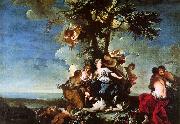 |
Giovanni Domenico Ferretti -- Click Here
|
|
1692-1768 Italian Giovanni Domenico Ferretti Location Italian painter. He was the son of the goldsmith Antonio di Giovanni da Imola and Margherita di Domenico Gori. His mother family, which included her brother, the antiquarian ANTONIO FRANCESCO GORI, was extremely influential in Florence and proved very important for Ferretti. In the first years of his life he lived in Imola, where he was sent to study (1708) with the local painter Francesco Chiusuri. After the family moved to Florence, Ferretti was taught there by Tommaso Redi and Sebastiano Galeotti. Later he spent five years in Bologna, an important centre for the practice and teaching of academic painting, where, in the workshop of Felice Torelli, his work acquired its characteristic style. |
|
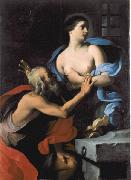 |
Giovanni Domenico Cerrini -- Click Here
|
|
(1609-1681), also called Gian Domenico Cerrini or il Cavalier Perugino, was an Italian painter of the Baroque period, active mainly in Rome and influenced in large part by painter of the Bolognese School.
Born in Perugia, Cerrini initially apprenticed under Giovanni Antonio Scaramuccia, then in 1638 moved into the Roman studio of Guido Reni, but strongly influenced by Lanfranco, Guercino, Domenichino, and Andrea Sacchi. He was patronized by the family of Cardinal Bernardino Spada. Cardinal Giulio Rospigliosi gave him the commission to decorate the cupola of Santa Maria della Vittoria (1654-5). His style has the monumental clarity of Domenichino, but somewhat sapped of vitality.
Paintings of his can be found in many of the churches of Rome, where he died, including Santa Maria in Traspontina, San Carlino alle Quattro Fontane, Chiesa Nuova, San Carlo ai Catinari, Santissimo Sudario dei Piemontesi, Sant??Isidoro, as well as in Galleria Colonna, Palazzo Spada, and the Palazzo Corsini art gallery. |
|
 |
Giovanni di Pietro called lo Spagna -- Click Here
|
|
ca 1450-Spoleto 1528 |
|
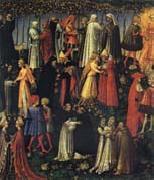 |
Giovanni di Paolo -- Click Here
|
|
Italian Early Renaissance Painter, ca.1403-1483,major Italian painter of the Sienese school. Typical of the Sienese painters of his era, he paid scant attention to the artistic innovations made in nearby Florence, but often depended on the style established by the Sienese masters of the 14th cent. Fortunately, Giovanni di Paolo was endowed with great imagination. His first dated work (1426) was the Pecci altarpiece (major panels in Siena; predella panels in the Walters Art Gall., Baltimore). He produced a tremendous number of works during his long career. Many paintings have remained in Siena, but there are probably more examples of his art in the United States. The Metropolitan Museum has several of his paintings; among them is a delightful scene of Paradise; in the Philip Lehman collection is the exquisite Creation of the World. The Madonna and Child in a Landscape (Mus. of Fine Arts, Boston) exemplifies his inclination toward pure fantasy and disregard for the laws of perspective. Giovanni di Paolo is best represented by six highly expressive scenes from the life of St. John the Baptist (Art Inst., Chicago). |
|
 |
Giovanni di Francesco -- Click Here
|
|
Italian Early Renaissance Painter, 1412-1459 |
|
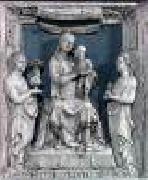 |
Giovanni di -- Click Here
|
|
active 1310-1347 in Siena |
|
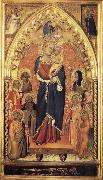 |
Giovanni del Biondo -- Click Here
|
|
Italian Gothic Era Painter, active 1356-1399,was a 14th century Italian painter of the Gothic and early-Renaissance period, active 1356-1399. |
|
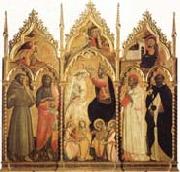 |
Giovanni dal ponte -- Click Here
|
|
Italian Painter, 1385-1437
He was reputed to have been a student of Spinello Aretino. He acquired the name dal Ponte due to the location of his studio at Santo Stefano a Ponte, Florence. He joined the Arte dei Medici e degli Speziali in 1410 and the Compagnia di S Luca in 1413. Outstanding debts brought him a prison sentence in 1424, but he still owed money to a carpenter three years later. By the late 1420s he had opened his own studio and formed a partnership with the painter Smeraldo di Giovanni (c. 1365-after 1442). Giovanni dal Ponte's varied and prolific production, which continued until his death, included fresco cycles, panels and the decoration of small objects. A number of allegorical panel paintings and cassoni are attributed to him. The animated, stylized figures in the Seven Liberal Arts (1435; Madrid, Prado) are shown in a garden dotted with naturalistic flowers and plants. His early work shows the impact of the Late Gothic style. |
|
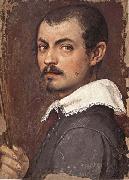 |
Giovanni da san giovanni -- Click Here
|
|
1592-1636
Italian painter and draughtman. He was the most distinguished of the artists working in fresco in 17th-century Florence. An eccentric personality, he was attracted by the charm and informality of northern art and by a satirical approach to Classical themes. He went to Florence in 1608 to study in the workshop of Matteo Rosselli, where he learnt both fresco and oil painting techniques and drew extensively (Baldinucci). In 1615 he painted two ceiling canvases of Putti Supporting the Impresa of Michelangelo for a room in the Casa Buonarroti and in the same period frescoed the dome of the church of the Ognissanti, Florence (completed 1615), with a choir of musician angels. He also painted five lunettes showing scenes from the Life of St Francis in the cloister (completed 1619; in situ). In 1616 his frescoed decoration of an Allegory of Florence (destr.; preparatory drawing, Florence, Uffizi, G.D.S. U. 1122F) on the fa?ade of Cosimo II de' Medici's house in Piazza della Calza won him unexpected and lasting fame. His early works also included several tabernacles, made for patrons in the town and in the surrounding countryside. The Virgin and Child with Saints |
|
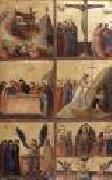 |
GIOVANNI DA RIMINI -- Click Here
|
|
Italian painter, Riminese school (active 1292-1309) |
|
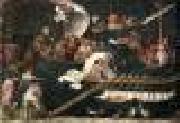 |
GIOVANNI DA MODENA -- Click Here
|
|
Italian painter, Bolognese school (active 1409-1456 in Bologna) |
|
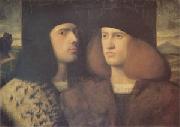 |
Giovanni Cariani -- Click Here
|
|
Venice 1480/85-1547 |
|
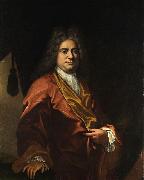 |
Giovanni Camillo Sagrestani -- Click Here
|
|
(1660-1731) was an Italian painter of the Baroque era.
A native of Florence, he was a follower of the style of Carlo Cignani. His major pupil was Matteo Bonechi (1672-1726) and Giovanni Battista Ranieri del Pace. Four canvases attributed to Sagrestani can be found in the church of Santa Maria della Fraternite in Foiano della Chiana. He also executed works in the church of San Frediano in Cestello, in the Oltrarno district of Florence. Paintings in the church of SS. Annunziata in San Giovanni Valdarno are attributed to Sagrestani. An Assumption of the Virgin is found in Nancy. |
|
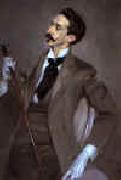 |
Giovanni Boldini -- Click Here
|
|
1842-1931
Italian
Giovanni Boldini Locations
Italian painter and printmaker. He received his earliest training from his father, the painter Antonio Boldini (1799-1872). From 1858 he may have attended courses given by Girolamo Domenichini (1813-91) and Giovanni Pagliarini (?1809-78) at the Civico Ateneo di Palazzo dei Diamanti, where he assiduously copied Old Masters. At 18 he was already known in Ferrara as an accomplished portrait painter. In 1862 he went to Florence, where he sporadically attended the Scuola del Nudo at the Accademia di Belle Arti. He frequented the Caffe Michelangiolo, a meeting-place of progressive artists, where he came into contact with the MACCHIAIOLI group of artists. |
|
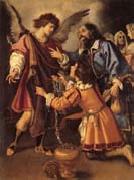 |
Giovanni Biliverti -- Click Here
|
|
Maestricht 1576-Florence 1644
|
|
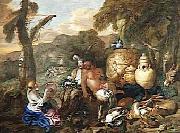 |
Giovanni Benedetto Castiglione -- Click Here
|
|
was an Italian Baroque artist, painter, printmaker and draftsman, of the Genoese school. He is best known now for his elaborate engravings, and as the inventor of the printmaking technique of monotyping. He was known as Il Grechetto in Italy and in France as Le Benedette.
|
|
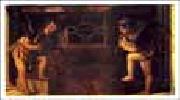 |
Giovanni Bellini -- Click Here
|
|
Italian High Renaissance Painter, ca.1430-1516
(b ?1431-6; d Venice, 29 Nov 1516). Painter and draughtsman, son of (1) Jacopo Bellini. Although the professional needs of his family background may have encouraged him to specialize at an early date in devotional painting, by the 1480s he had become a leading master in all types of painting practised in 15th-century Venice. Later, towards the end of his long life, he added the new genres of mythological painting and secular allegory to his repertory of subject-matter. His increasing dominance of Venetian art led to an enormous expansion of his workshop after c. 1490; and this provided the training-ground not only for his numerous shop-hands and imitators (generically known as Belliniani) but probably also for a number of major Venetian painters of the next generation. Throughout his career, Giovanni showed an extraordinary capacity for absorbing a wide range of artistic influences, both from within Venetian tradition and from outside. He also oversaw a technical revolution in the art of painting, involving the gradual abandonment of the traditional Italian use of egg tempera in favour of the technique of oil painting pioneered in the Netherlands. It was thanks to Giovanni Bellini that the Venetian school of painting was transformed during the later 15th century from one mainly of local significance to one with an international reputation. He thus set the stage for the triumphs of Venetian painting in the 16th century and for the central contribution that Venice was to make to the history of European art. |
|
 |
Giovanni Battista Tiepolo -- Click Here
|
|
Italian Rococo Era Painter, 1696-1770
Giovanni Battista Tiepolo was born in Venice on March 5, 1696. His father, who was part owner of a ship, died when Tiepolo was scarcely a year old, but the family was left in comfortable circumstances. As a youth, he was apprenticed to Gregorio Lazzarini, a mediocre but fashionable painter known for his elaborately theatrical, rather grandiose compositions.
Tiepolo soon evolved a more spirited style of his own. By the time he was 20, he had exhibited his work independently, and won plaudits, at an exhibition held at the church of S. Rocco. The next year he became a member of the Fraglia, or painters guild. In 1719 he married Cecilia Guardi, whose brother Francesco was to become famous as a painter of the Venetian scene. They had nine children, among them Giovanni Domenico and Lorenzo Baldassare, who were also painters.
In the 1720s Tiepolo carried out many large-scale commissions on the northern Italian mainland. Of these the most important is the cycle of Old Testament scenes done for the patriarch of Aquileia, Daniele Dolfin, in the new Archbishop Palace at Udine. Here Tiepolo abandoned the dark hues that had characterized his early style and turned instead to the bright, sparkling colors that were to make him famous. |
|
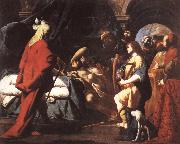 |
Giovanni Battista Spinelli -- Click Here
|
|
( fl from c. 1630; dc. 1660). Italian painter and draughtsman |
|
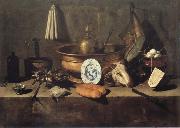 |
Giovanni Battista Recco -- Click Here
|
|
Italian, 1615-1660 |
|
 |
Giovanni Battista Pittoni -- Click Here
|
|
Giambattista Pittoni (June 6, 1687-November 6, 1767) was an Italian painter of the late-Baroque or Rococo period, active mainly in his native Venice.
Pittoni was born in Venice, and studied painting under his uncle Francesco Pittoni and Antonio Balestra. Little is known of his early career. He entered the Venetian painters' guild in 1716. In 1722-1723, he was commissioned to paint eThe Torture of St Thomase for San Stae in Venice, which also contains one if his later works in its sacristy. He also completed the transit of Santa Maria in Organo in Verona in 1725. In 1727, he was appointed honorary Academician of the Accademia Clementina in Bologna. In subsequent years, Pittoni never left his native Venice, but completed a number of important and lucrative commissions from German, Polish, Russian, Italian and Austrian patrons, including eThe Sacrifice of Jephthah's daughtere for the Royal Palace of Turin, a number of works for the Marshal von Schulenburg, and a eMartyrdom of St Batholomewe for the Basilica of Saint Anthony of Padua. Pittoni came to be known for his "grand-manner" canvases depicting religious, historical, and mythological subjects (such as Sophonisba and Polyxena).
By 1740, he established a studio and residence in the San Giacomo district of Venice, and took on numerous apprentices. Pittoni died at age 80 on November 6, 1767. His tomb is at the church of San Giacomo dall'Orio in Venice.
Pittoni was a co-founder of the official painter's academy in Venice (in competition to the old fraglia or painter's guild), the Accademia di Belle Arti di Venezia, and he succeeded as President (1758-1761) his contemporary Giovanni Battista Tiepolo. His mature palette was noted, as was Tiepolo's, for his lightness of tone. Besides Tiepolo, Pittoni's influences were Giovanni Battista Piazzetta, Sebastiano Ricci, and Antonio Balestra. His paintings were of a Rococo style, but later became more sedate in their approach towards Neoclassicism. |
|
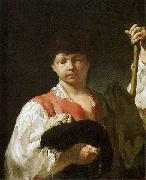 |
Giovanni Battista Piazzetta -- Click Here
|
|
(also called Giambattista Piazzetta or Giambattista Valentino Piazzetta) (February 13, 1682 or 1683 ?C April 28, 1754) was an Italian rococo painter of religious subjects and genre scenes.
Piazzetta was born in Venice, the son of a sculptor Giacomo Piazzetta, from whom he had early training in wood carving. Starting in 1697 he studied with the painter Antonio Molinari. By Piazzetta's account, he studied under Giuseppe Maria Crespi while living in Bologna in 1703-05, although there is no record by Crespi of formal tutelage. Piazzetta did find inspiration in Crespi's art, in which the chiaroscuro of Caravaggio was transformed into an idiom of graceful charm. He was also greatly impressed by the altarpieces created by another Bolognese painter of a half-century earlier, Guercino.
Around 1710, he returned to Venice. There he won recognition as a leading artist despite his limited output and his unassuming nature, but he ultimately was less patronized, both in Venice and especially abroad, than two other eminent stars in Venetian late-Baroque/Rococo, Ricci and Tiepolo. These two painters had a luminous palette and facile ease that allowed them to carpet meters of ceiling with frescoes, although with a superficiality and glamor that is absent from Piazzetta's darker and more intimate depictions. Nonetheless,Tiepolo, who collaborated with Piazzetta on some projects, was greatly influenced by the older artist; in turn, the luminosity and brilliance of Tiepolo's palette would influence Piazzetta in his later years.
Piazzetta created an art of warm, rich color and a mysterious poetry. He often depicted peasantry, even if often in a grand fashion. He was highly original in the intensity of color he sometimes used in his shadows, and in the otherworldly quality he gave to the light which throws part of a composition into relief. The gestures and glances of his protagonists hint at unseen dramas, as in one of his best-known paintings, The Soothsayer(1740, now in Gallerie dell'Accademia, Venice). He brought similar elusiveness to works of a religious nature, such as the Sotto in su Glory of St. Dominic in the Church of Santi Giovanni e Paolo.
Also notable are his many carefully rendered drawings of half-length figures or groups of heads. Usually in charcoal or black chalk with white heightening on gray paper, these are filled with the same spirit that animates his paintings, and were purchased by collectors as independent works. He also produced engravings.
In 1750 Piazzetta became the first director of the newly founded Scuola di Nudo, and he devoted himself in the last few years of his life to teaching. He was elected a member of the Bolognese Accademia Clementina in 1727. Among the painters in his studio were Domenico Maggiotto, Francesco Dagiu (il Capella), John Henry Tischbien the Elder, Egidio Dall'Oglio, and Antonio Marinetti.[1] Among younger painters who emulated his style are Giulia Lama, Federico Bencovich, and Francesco Polazzo (1683?C1753). He died in Venice in 1754.
|
|
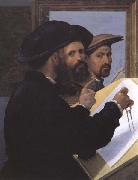 |
Giovanni Battista Paggi -- Click Here
|
|
Italian Baroque Era Painter, 1554-1627
Italian painter and theorist. As the son of a newly inscribed nobleman, he received a Renaissance gentleman's education, but as an artist he was it seems self-taught, despite the encouragement of Luca Cambiaso. The gentleman who then set up as a painter was obliged to give his work to patrons, sometimes expecting future remuneration; but when one patron reneged on payment in 1581, Paggi mortally wounded him and was banished from Genoa. He was given protection by Francesco I de' Medici, Grand Duke of Tuscany, and settled in Florence. A fresco of St Catherine Converting Two Criminals (1582), painted for Niccol? Gaddi's family chapel at S Maria Novella and thoroughly Florentine in manner, established Paggi's reputation at the Medici court. He painted ephemeral decorations, portraits (all untraced) and altarpieces for many Florentine churches and for the cathedrals of San Gimignano (c. 1590), Pistoia (1591-3) and Lucca (1597-8), having his studio in a house owned by Federico Zuccaro. |
|
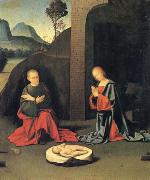 |
Giovanni Battista Ortolano -- Click Here
|
|
Ferrara ca 1487-after 1524 |
|
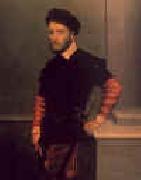 |
Giovanni Battista Moroni -- Click Here
|
|
Italian
c1520-1578
was a North Italian painter of the Late Renaissance period. He is also called Giambattista Moroni. Best known for his elegantly realistic portraits of the local nobility and clergy, he is considered one of the great portrait painters of sixteenth century Italy.
The National Gallery (London) has one of the best collections of his work, including the celebrated portrait known as Il Sarto (The Tailor, a member of the Fenaroli family, illustration). Other portraits are found in the Uffizi (the Nobleman Pointing to Flame inscribed "Et quid volo nisi ut ardeat?"), Berlin Gallery, the Canon Ludovico de' Terzi and Moroni's self-portrait; and in the National Gallery, Washington, the seated half-figure of the Jesuit Ercole Tasso, traditionally called "Titian's Schoolmaster", although there is no real connection with Titian.
The Accademia Carrara (Bergamo) (Portrait of an old man). Ashmolean Museum (University of Oxford), Brooks Museum of Art (Memphis, Tennessee), Detroit Institute of Arts, the Fine Arts Museums of San Francisco, the Hermitage Museum, the Honolulu Academy of Arts, Kunsthistorisches Museum (Vienna), the Liechtenstein Museum (Vienna), the Musee du Louvre, Mus??e Cond?? Chantilly (Chantilly, France), Museo Poldi Pezzoli (Milan), the Museum of Fine Arts, Boston, National Galleries of Scotland, the National Gallery of Art (Washington D.C.), the National Gallery of Australia, the National Gallery of Canada, the National Gallery, London, the Norton Simon Museum (Pasadena, California), Pinacoteca Ambrosiana (Milan), Pinacoteca di Brera (Milan), Rijksmuseum, the Ringling Museum of Art (Florida), Studio Esseci (Padua, Italy), University of Arizona Museum of Art, Virginia Museum of Fine Arts and the Uffizi (Portrait of Giovanni Antonio Pantera) are among the public collections holding works by Giovanni Battista Moroni. |
|
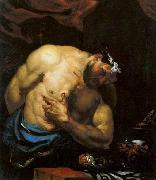 |
Giovanni Battista Langetti -- Click Here
|
|
Giovanni Battista Langetti (1625 - 1676), also known as Giambattista Langetti, was an Italian late-Baroque painter. He was active in his native Genoa, then Rome, and finally for the longest period in Venice.
He first trained with Assereto, then Pietro da Cortona, but afterwards studied under Giovanni Francesco Cassana, appeared in Venice by 1650s were he worked in a striking Caravaggesque style. He is thought to have influenced Johann Karl Loth and Antonio Zanchi. He painted many historical busts for private patrons in the Venetian territory and in Lombardy. He died at Venice in 1676.
|
|
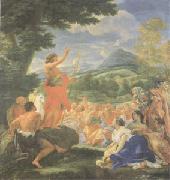 |
Giovanni Battista Gaulli Called Baccicio -- Click Here
|
|
Genoa 1639-Rome 1709 |
|
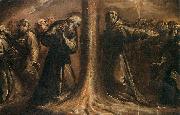 |
Giovanni Battista Crespi -- Click Here
|
|
Giovanni Battista Crespi (23 December 1573 - 23 October 1632), called Il Cerano, was an Italian painter, sculptor, and architect.
He was born in Romagnano Sesia, the son of a painter, Raffaele Crespi, and moved to Cerano with his family some years later. In 1591 he is known to have been living in Milan.
True to the Counter-Reformation piety zealously expressed in Milanese art of his time, his paintings focus on mysteries and mystical episodes in saintly life. The crowded canvases and the angles recall Mannerism, but his paintings show an emotion that evokes common sentiments in Baroque art. Along with other artists, he completed a series of paintings (Quadroni of St. Charles) of the life of St. Charles Borromeo[1] for the Duomo of Milan, an altarpiece with the Baptism of St. Augustine for San Marco (Milan), and a Mass of St. Gregory for the Basilica of San Vittore in Varese (1615-17). Also see the nightmarish, St. Gregory Delivers the Soul of a Monk (1617), also in San Vittore. |
|
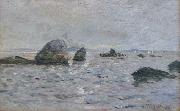 |
Giovanni Battista Castagneto -- Click Here
|
|
painted Seascape in 1851 - 1900 |
|
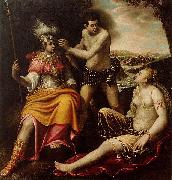 |
Giovanni Baglione -- Click Here
|
|
(1566 - 30 December 1643) was an Italian Late Mannerist and Early Baroque painter and art historian. He is best remembered for his acrimonious involvement with the artist Caravaggio and his writings concerning the other Roman artists of his time.
A pupil of Francesco Morelli, he worked mainly in Rome, initially with a late-Mannerist style. He was also nicknamed Il Sordo del Barozzo.
|
|
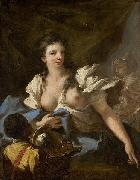 |
Giovanni Antonio Pellegrini -- Click Here
|
|
(29 April 1675 -- November 1741) was a widely-travelled Rococo decorative painter from Venice, where he was born and died. He is considered to be one of the most important Venetian painters of the early 18th century, melding the Renaissance style of Paolo Veronese with the Baroque of Pietro da Cortona and Luca Giordano,and is considered an important predecessor of Giovanni Battista Tiepolo. One of his pupils was Antonio Visentini.
Pellegrini's father, also Antonio, was a shoemaker from Padua. Pellegrini first studied under Girolamo Genga, but was later a pupil of Paolo Pagani and of Sebastiano Ricci. He married Angela Carriera, the sister of Rosalba Carriera, in c.1704. Pellegrini decorated the dome above the staircase at the Scuola Grande di San Rocco in 1709.
He is mainly known for his work in England, which he visited from 1708 to 1713 at the invitation of the Earl of Manchester, and where he had considerable success. He painted murals in a number of English country houses, including Castle Howard (mostly destroyed in 1940) and Kimbolton Castle, Narford Hall, and in London, 31 St James's Square for the Duke of Portland, where George Vertue noted in his notebooks "the hall and Staircase and one or two of the great rooms". He became a director of Sir Godfrey Kneller's Academy in London in 1711. He submitted designs for the decorating the interior dome of the new St Paul's Cathedral, and is said to have been Christopher Wren's favourite painter, but did not win the commission, losing out to Sir James Thornhill.
|
|
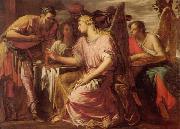 |
Giovanni Antonio Fumiani -- Click Here
|
|
(1645-1710) was an Italian painter of the Baroque period.
Born in Venice in 1645, he trained in Bologna under Domenico degli Ambrogi, a specialist in quadratura, but by 1668 he was back in Venice, where he painted a Virgin and Saints in San Benedetto. He was influenced by Ludovico Carracci and Alessandro Tiarini, and soon also became interested in the work of Paolo Veronese, so that he started to use elaborate architectural settings and brighter colours. He painted a Virgin Appearing to Pius V (1674; Vicenza, S Lorenzo), whose monumentality foreshadows Tiepolo, whereas mosaics in San Marco, created in 1677 from Fumianies cartoons, are closer to the idiosyncratic art of Pietro della Vecchia. He contributed to the decoration of San Rocco (1675, 1676, 1678), where he painted a large canvas of the Charity of St Roch on the ceiling of the nave, In his smaller paintings, however, such as the modelli (Florence, Uffizi) painted for the Ferdinand de Medici, Grand Prince of Tuscany, for whom he worked for a long time, with Niccole Cassana acting as intermediary, Fumiani revealed a lively decorative sense and a taste for animated, sensual subjects that produced works of great quality. His last work is the large lunette depicting Frederick III visiting St Zacharyes Convent in the Company of the Doge (Venice, San Zaccaria).
The decoration of San Pantalon with scenes from the Life of St Pantaleon (1680-1704) utilized canvases to cover a large ceiling (25x50 m), an ambitious undertaking, both in its scale and in the unity of the magniloquent images, that parallels Andrea Pozzoes decoration at the church of Sant'Ignazio in Rome. Fumiani was responsible for painting what is claimed to the largest painting on canvas in the world and covers the whole of the ceiling of the church Chiesa di San Pantaleone Martire, known as San Pantalon, in Venice. The painting depicts The Martyrdom and Apotheosis of St Pantalon, which he painted from 1680 until 1704. He putatively died from a fall from a scaffold, although some sources date his death to six years after he stopped work on the canvas
|
|
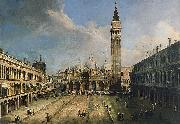 |
Giovanni Antonio Canal -- Click Here
|
|
(28 October 1697 - 19 April 1768) better known as Canaletto, was a Venetian painter famous for his landscapes, or vedute, of Venice. He was also an important printmaker in etching.
He was born in Venice as the son of the painter Bernardo Canal, hence his mononym Canaletto ("little Canal"), and Artemisia Barbieri. His nephew and pupil Bernardo Bellotto was also an accomplished landscape painter, with a similar painting style, and sometimes used the name "Canaletto" to advance his own career, particularly in countrieseGermany and Polandewhere his uncle was not active.
|
|
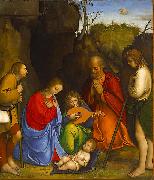 |
Giovanni Agostino da Lodi -- Click Here
|
|
was an Italian painter who was active from c. 1495 to c. 1525.
The attribution of his works has been dubious for centuries, until his style and career was defined by the American art historian Bernard Berenson in the 1960s. One of his first identified work is the Pala dei Barcaioli ("Boatmen Altarpiece") in the church of San Pietro Martire at Murano. His only signed work is the St. Peter and St. John the Evangelist in the Pinacoteca di Brera, which shows Lombard influeces, such as that of Bramantino.
Later he was also influenced by Leonardo da Vinci's style, as visible in the Christ Washing the Feet of the Apostles in the Gallerie dell'Accademia of Venice. After moving to Venice in the wake of Ludovico Sforza's fall, he returned to Milan in 1506. He subsequently executed works for privates and for the Certosa di Pavia; one of his late works, the Calvary, is housed in the National Gallery in Prague. He also collaborated with Marco d'Oggiono for a polyptych in the church of Santa Maria della Pace in Milan, some panels of which are now in the Pinacoteca di Brera.
|
|
 |
Giovanni Giacometti -- Click Here
|
|
1868-1933
Swiss
Giovanni Giacometti Galleries
was a Swiss painter. He was the father of the artists Alberto and Diego Giacometti and the architect Bruno Giacometti. |
|
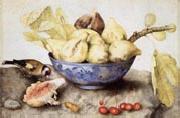 |
Giovanna Garzoni -- Click Here
|
|
Italian Baroque Era Painter, 1600-1670
was an Italian painter of the Baroque era. She was unusual for Italian artists of the time for two reasons: first, in that her themes were mainly decorative and luscious still-lifes of fruits, vegetables, and flowers, and second, because she was a woman. Her training was with an otherwise unknown painter from her native town of Ascoli Piceno. She gained substantial success at her trade in Rome, Venice, Florence (1642-1651), Naples, and Turin. She was patronized by Cassiano dal Pozzo and the wife of Taddeo Barberini, Anna Colonna. In Turin she painted for Carlo Emanuele II, Duke of Savoy. She returns to Rome in the 1650s. In 1666, Garzoni bequeathed her entire estate to the Roman painters' guild the Accademia di San Luca, on condition that they build her tomb in their church of Santi Luca e Martina. Her tomb monument by Mattia De Rossi is to the right of the entrance. Laura Bernasconi was also a woman painter of still-life flowers in Rome in the 1670s. In Rome, she would have been a contemporary of Caterina Ginnasi. It is likely that in Naples she was exposed to the still-lifes of Giovan Battista Ruoppolo and his contemporaries. |
|
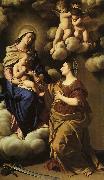 |
Giovan Battista Salvi Sassoferrato -- Click Here
|
|
1605-1685
Italian
Giovan Battista Salvi Sassoferrato Gallery |
|
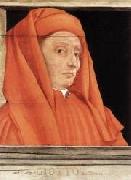 |
GIOTTO di Bondone -- Click Here
|
|
Italian Early Renaissance Painter, 1267-1337
Italian painter and designer. In his own time and place he had an unrivalled reputation as the best painter and as an innovator, superior to all his predecessors, and he became the first post-Classical artist whose fame extended beyond his lifetime and native city. This was partly the consequence of the rich literary culture of two of the cities where he worked, Padua and Florence. Writing on art in Florence was pioneered by gifted authors and, although not quite art criticism, it involved the comparison of local artists in terms of quality. The most famous single appreciation is found in Dante's verses (Purgatory x) of 1315 or earlier. Exemplifying the transience of fame, first with poets and manuscript illuminators, Dante then remarked that the fame of Cimabue, who had supposed himself to be the leader in painting, had now been displaced by Giotto. Ironically, this text was one factor that forestalled the similar eclipse of Giotto's fame, which was clearly implied by the poet. |
|
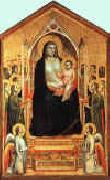 |
Giotto -- Click Here
|
|
Italian
1267-1337
Giotto Galleries
Giotto di Bondone (c. 1267 ?C January 8, 1337), better known simply as Giotto, was an Italian painter and architect from Florence. He is generally considered the first in a line of great artists who contributed to the Italian Renaissance.
Giotto's contemporary Giovanni Villani wrote that Giotto was "the most sovereign master of painting in his time, who drew all his figures and their postures according to nature. And he was given a salary by the commune [of Florence] in virtue of his talent and excellence."
The later 16th century biographer Giorgio Vasari says of him "...He made a decisive break with the ...Byzantine style, and brought to life the great art of painting as we know it today, introducing the technique of drawing accurately from life, which had been neglected for more than two hundred years."
Giotto's masterwork is the decoration of the Scrovegni Chapel in Padua, commonly called the Arena Chapel, completed around 1305. This fresco cycle depicts the life of the Virgin and the life of Christ. It is regarded as one of the supreme masterpieces of the Early Renaissance. That Giotto painted the Arena Chapel and that he was chosen by the commune of Florence in 1334 to design the new campanile (bell tower) of the Florence Cathedral are among the few certainties of his biography. Almost every other aspect of it is subject to controversy: his birthdate, his birthplace, his appearance, his apprenticeship, the order in which he created his works, whether or not he painted the famous frescoes at Assisi, and where he was eventually buried after his death. |
|
1.jpg) |
GIOTTINO (Giotto di Stefano) -- Click Here
|
|
Italian painter, Florentine school (b. 1320/30, Firenze, d. after 1369, Firenze) |
|
 |
Giottino -- Click Here
|
|
1325-1370
Italian
Giottino Gallery
was an early Italian painter from Florence. His real name was Maso di Stefano or Tommaso di Stefano.
Giottino's father was himself a celebrated painter; his naturalism earned him the appellation "Scimia della Natura" (Ape of Nature). He instructed his son, who applied himself with greater predilection to studying the works of the great Giotto. Since he formed his style on Giotto's works, Maso became known as Giottino.
The frescoes in the chapel of San Silvestro in the Florentine Basilica of Santa Croce are attributed to Giottino; these represent the miracles of Pope St Sylvester as narrated in the "Golden Legend".
A large number of other works have been attributed to Giottino including Apparition of the Virgin to St Bernard and a marble statue erected on the Florentine campanile. |
|
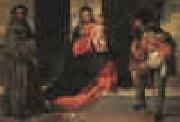 |
Giorgione -- Click Here
|
|
Italian
1476-1510
Giorgione Galleries
For his home town of Castelfranco, Giorgione painted the Castelfranco Madonna, an altarpiece in sacra conversazione form ?? Madonna enthroned, with saints on either side forming an equilateral triangle. This gave the landscape background an importance which marks an innovation in Venetian art, and was quickly followed by his master Giovanni Bellini and others.Giorgione began to use the very refined chiaroscuro called sfumato ?? the delicate use of shades of color to depict light and perspective ?? around the same time as Leonardo. Whether Vasari is correct in saying he learnt it from Leonardo's works is unclear ?? he is always keen to ascribe all advances to Florentine sources. Leonardo's delicate color modulations result from the tiny disconnected spots of paint that he probably derived from manuscript illumination techniques and first brought into oil painting. These gave Giorgione's works the magical glow of light for which they are celebrated.
Most entirely central and typical of all Giorgione's extant works is the Sleeping Venus now in Dresden, first recognized by Morelli, and now universally accepted, as being the same as the picture seen by Michiel and later by Ridolfi (his 17th century biographer) in the Casa Marcello at Venice. An exquisitely pure and severe rhythm of line and contour chastens the sensuous richness of the presentment: the sweep of white drapery on which the goddess lies, and of glowing landscape that fills the space behind her, most harmoniously frame her divinity. The use of an external landscape to frame a nude is innovative; but in addition, to add to her mystery, she is shrouded in sleep, spirited away from accessibility to her conscious expression.
It is recorded by Michiel that Giorgione left this piece unfinished and that the landscape, with a Cupid which subsequent restoration has removed, were completed after his death by Titian. The picture is the prototype of Titian's own Venus of Urbino and of many more by other painters of the school; but none of them attained the fame of the first exemplar. The same concept of idealized beauty is evoked in a virginally pensive Judith from the Hermitage Museum, a large painting which exhibits Giorgione's special qualities of color richness and landscape romance, while demonstrating that life and death are each other's companions rather than foes.
Apart from the altarpiece and the frescoes, all Giorgione's surviving works are small paintings designed for the wealthy Venetian collector to keep in his home; most are under two foot (60 cm) in either dimension. This market had been emerging over the last half of the fifteenth century in Italy, and was much better established in the Netherlands, but Giorgione was the first major Italian painter to concentrate his work on it to such an extent ?? indeed soon after his death the size of such paintings began to increase with the prosperity and palaces of the patrons. |
|
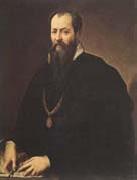 |
Giorgio Vasari -- Click Here
|
|
1511-74
Italian painter, architect, and writer. Though he was a prolific painter in the Mannerist style, he is more highly regarded as an architect (he designed the Uffizi Palace, now the Uffizi Gallery), but even his architecture is overshadowed by his writings. His Lives of the Most Eminent Architects, Painters, and Sculptors (1550) offers biographies of early to late Renaissance artists. His style is eminently readable and his material is well researched, though when facts were scarce he did not hesitate to fill in the gaps. In his view, Giotto had revived the art of true representation after its decline in the early Middle Ages, and succeeding artists had brought that art progressively closer to the perfection achieved by Michelangelo. |
|
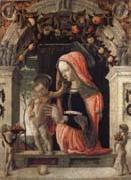 |
Giorgio Schiavone -- Click Here
|
|
born circa 1433-1504 |
|
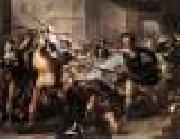 |
GIORDANO, Luca -- Click Here
|
|
Italian Baroque Era Painter, ca.1634-1705
,Italian painter and draughtsman, active also in Spain. He was one of the most celebrated artists of the Neapolitan Baroque, whose vast output included altarpieces, mythological paintings and many decorative fresco cycles in both palaces and churches. He moved away from the dark manner of early 17th-century Neapolitan art as practised by Caravaggio and his followers and Jusepe de Ribera, and, drawing on the ideas of many other artists, above all the 16th-century Venetians and Pietro da Cortona, he introduced a new sense of light and glowing colour, of movement and dramatic action. |
|
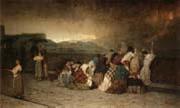 |
Gioacchino Toma -- Click Here
|
|
Italian , Galatina 1836 - Napoli 1891
Italian painter. He was orphaned at the age of six and spent an unhappy childhood and adolescence in convents and poorhouses; these experiences would later provide subjects for his paintings. He was first taught drawing at the art school in the hospice for the poor in the Adriatic town of Giovinazzo, but in 1855 he moved to Naples, where he worked for an ornamental painter named Alessandro Fergola. In 1857 he was mistakenly arrested for conspiracy and exiled to Piedimonte d'Alife, 60 km from Naples, where he was initiated into the secret society of the Carbonari by some local liberal aristocrats who also became his first patrons. His paintings for them were mainly still-lifes, largely in the traditional Neapolitan style. On his return to Naples in 1858 he became a student at the Accademia di Belle Arti, attending the classes of Domenico Morelli, who influenced such early works as Erminia (1859; Naples, Pal. Reale). Toma fought for two years with Garibaldi in the campaign for the unification of Italy, then returned to painting, |
|
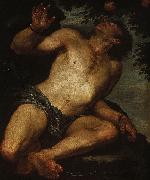 |
Gioacchino Assereto -- Click Here
|
|
(1600 - 28 June 1649) was an Italian painter of the early Baroque period, active in Genoa.
Gioacchino Assereto, David with the Head of Goliath.He initially apprenticed with Luciano Borzone and later Giovanni Andrea Ansaldo. He painted two vault frescoes in the church of Santissima Annunziata del Vastato: David and Abimelech and Santi Giovanni and Pietro healing the lame. He also shows the influence of Bernardo Strozzi, a tenebrism moderated by venetian coloristic effects and garbing the subjects in modern peasant garb, in paintings such as Moses obtaining water from the Rock (Prado Museum, Madrid). Orazio dee Ferrari may have worked with Assereto in Ansaldoes studio.
Paintings by Gioacchino Assereto can also be seen at the Detroit Institute of Art and the Museum of Fine Arts in Budapest,Hungary.
|
|
|
|
|
| | |
|
|
|
|